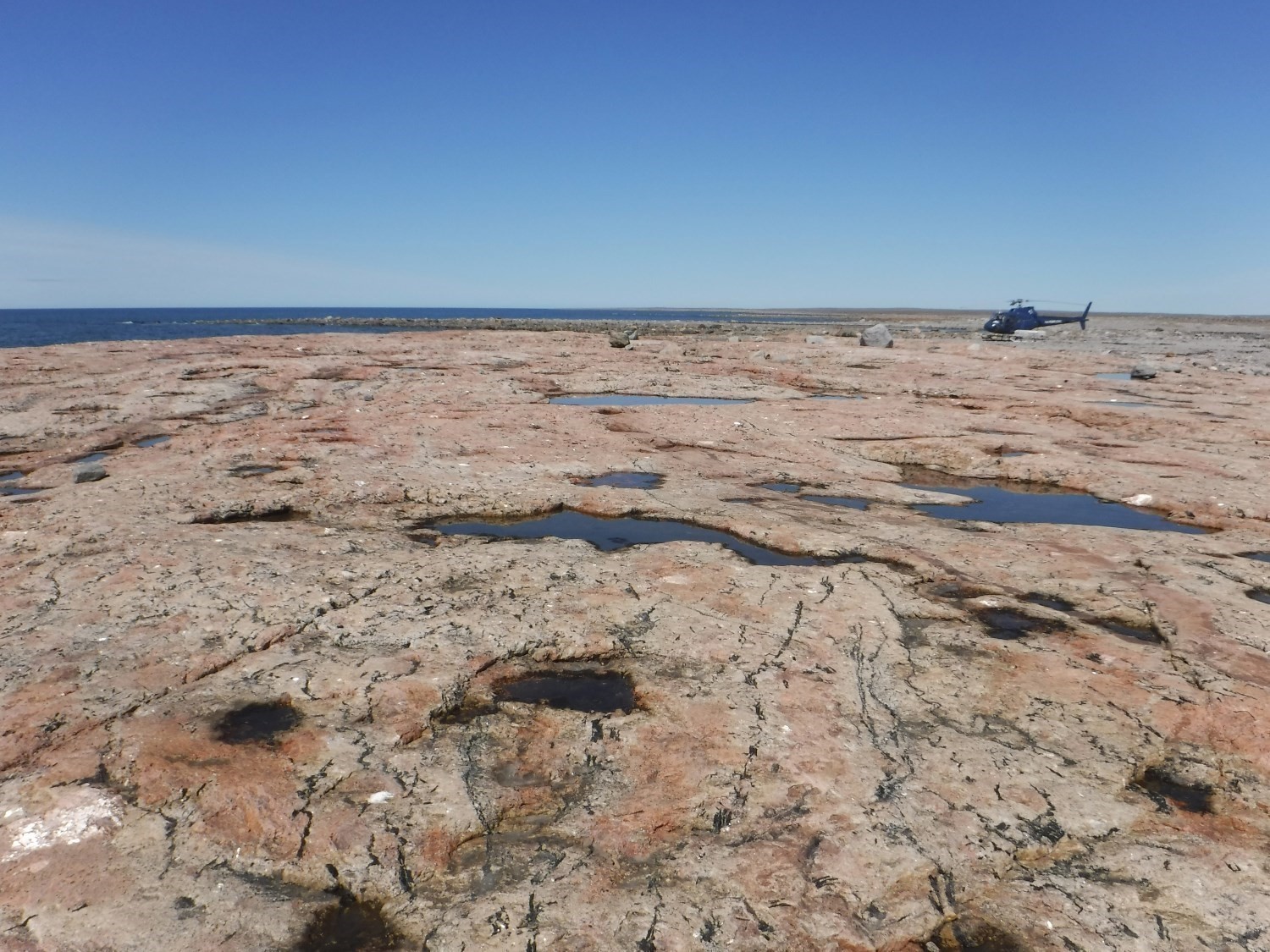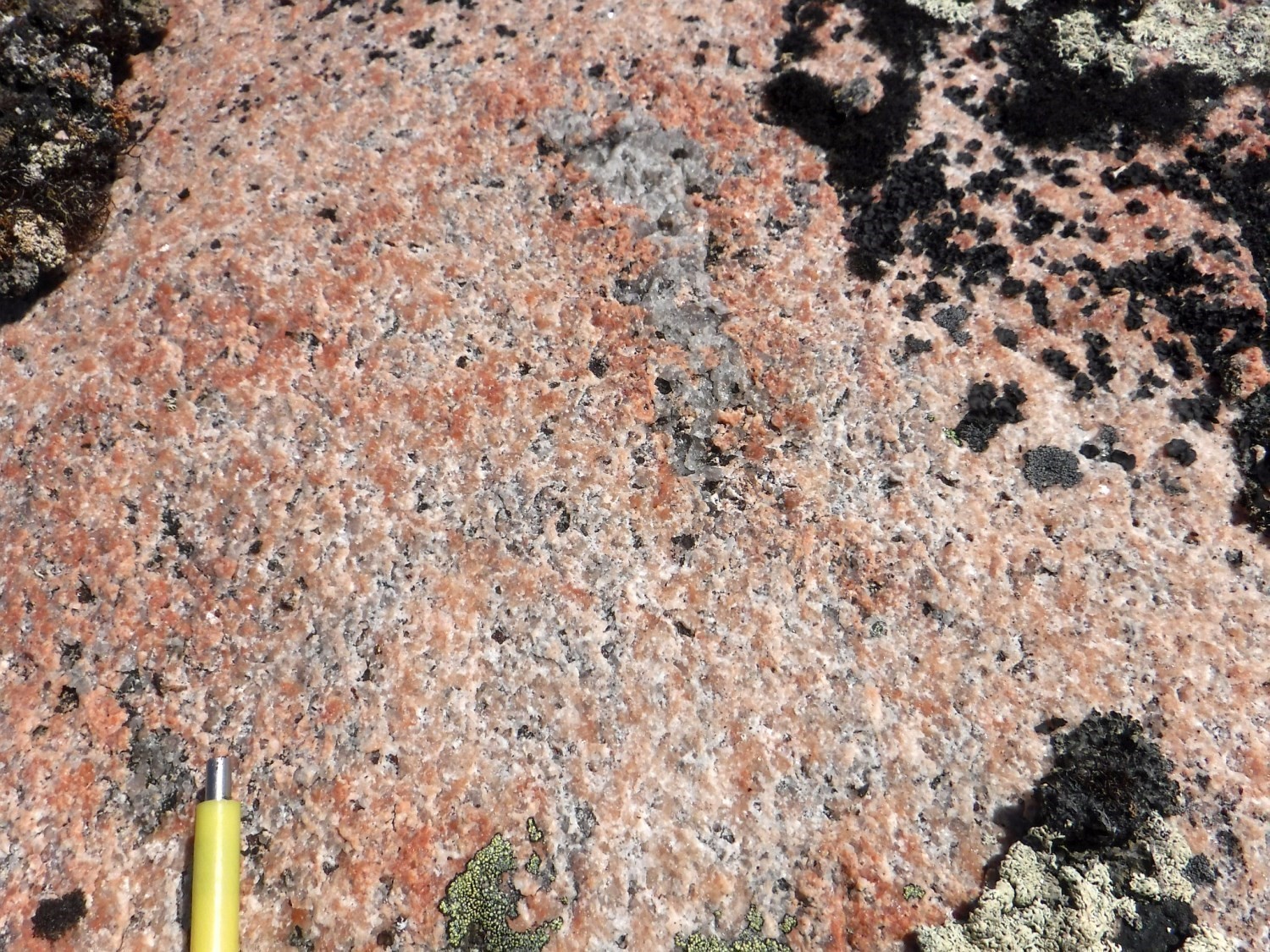
Last modified: 23 October 2020
Translation of original French
| Author: | Charette and Beaudette, 2018 |
| Age: | Paleoproterozoic |
| Stratotype: |
Sanningajualuk Hill near the village of Ivujivik, NTS sheet 32K05 (type locality) |
| Type area: |
NW part of the Ungava Peninsula |
| Geological province: | Churchill Province |
| Geological subdivision: | Ungava Orogen / Narsajuaq Lithotectonic Domain |
| Lithology: | Granitic intrusive rock |
| Category: | Lithodemic |
| Rank: | Suite |
| Status: | Formal |
| Use: | Active |
None
Background
The Sanningajualuk Suite, whose namesake hill is located south of the Inuit community of Ivujivik, was introduced by Charette and Beaudette (2018) to describe late potassic intrusions of the Narsajuac Lithotectonic Domain (formely the Narsajuaq Arc). These intrusive rocks were previously described by St-Onge and Lucas (1992) and St-Onge et al. (1992) as included in the younger plutonic suite of the Narsajuaq Arc, specifically in unit pPNAR4. Dunphy and Ludden (1998) described this suite as an “anatectic suite”. Charette and Beaudette (2018) preferred to distinguish late-orogenic to postorogenic intrusions into different formal units, including the Sanningajualuk Suite, in order to highlight their variable textures, their different intrusion (cross-cutting) and to comply with the North American Statigraphic Code (1983, 2005). This suite has been extended in the Sirmiq Lake area (Vanier and Lafrance, 2020).
Description
The Sanningajualuk Suite is the main unit of late-orogenic to postorogenic intrusions of the Narsajuaq Domain by its volume and distribution over the entire arc’s N-S axis. It is divided into two informal units: the main unit of foliated to massive syenogranite and monzogranite (pPsnn1) and the secondary unit of graphic-textured granite (pPsnn1a).
Sanningajualuk Suite 1 (pPsnn1): Foliated to Massive Syenogranite and Monzogranite
 Unit pPsnn1 consists mostly of syenogranite, which is characterized by its pink to reddish pink colour and its low content in ferromagnesian minerals (<10%). This unit includes, in a lesser proportion, a pinkish beige monzogranite with a coarser-grained syenogranitic pinkish phase in bands or diffuse clusters. Syenogranite and monzogranite share the same structural and textural characteristics. At the outcrop scale, both are characterized by fine to coarse grain variation and, in general, traces of hematite. These granitoids usually show weakly-developed foliation, marked by discontinuous millimetric biotite laminae. In close proximity to regional deformation zones, potassic intrusions of the pPsnn1 unit have strong foliation, contain K-feldspar porphyroclasts a few millimetres to one centimetre and, in places, quartz bands or stretch lineation marked by quartz rods.
Unit pPsnn1 consists mostly of syenogranite, which is characterized by its pink to reddish pink colour and its low content in ferromagnesian minerals (<10%). This unit includes, in a lesser proportion, a pinkish beige monzogranite with a coarser-grained syenogranitic pinkish phase in bands or diffuse clusters. Syenogranite and monzogranite share the same structural and textural characteristics. At the outcrop scale, both are characterized by fine to coarse grain variation and, in general, traces of hematite. These granitoids usually show weakly-developed foliation, marked by discontinuous millimetric biotite laminae. In close proximity to regional deformation zones, potassic intrusions of the pPsnn1 unit have strong foliation, contain K-feldspar porphyroclasts a few millimetres to one centimetre and, in places, quartz bands or stretch lineation marked by quartz rods.
Petrographic study of the granite indicates that these rocks are formed by several phases in diffuse contact. A coarse-grained phase, usually richer in K-feldspar and with a smaller proportion of ferromagnesian minerals, occurs as diffuse clusters or bands in a main rock, fine to medium-grained. Biotite is the dominant ferromagnesian mineral and is partially chloritized. Hornblende occurs in ferromagnesian clusters in some samples. It is commonly matted and is partially replaced by biotite. Euhedral allanite crystals are generally observed in association with ferromagnesian laminae or clusters. Few accessory minerals, such as apatite, muscovite, epidote and zircon, are observed in thin sections. In deformed zones, the quartzofeldspathic matrix is oriented and has numerous microfractures. Quartz is characterized by subgrain extinction.
Sanningajualuk Suite 1a (pPsnn1a): Granite with Graphic Texture
 Areas where the Sanningajualuk Suite granite has a graphic texture have been grouped in subunit pPsnn1a. In these areas, grain size ranges from medium to pegmatitic and altered surface colour changes from white to pinkish. In places, K-feldspar crystals can reach decimetric dimensions and usually have graphic texture.
Areas where the Sanningajualuk Suite granite has a graphic texture have been grouped in subunit pPsnn1a. In these areas, grain size ranges from medium to pegmatitic and altered surface colour changes from white to pinkish. In places, K-feldspar crystals can reach decimetric dimensions and usually have graphic texture.
Thickness and Distribution
Granitic intrusions of the Sanningajualuk Suite form kilometre-long intrusive masses elongated in the regional tectonic grain. Locally, they are elliptical and cut regional foliation. The largest and most homogeneous mass is located in the Ivujivik village area (sheet 35K05). Granitoids of this suite are also observed as metric intrusions, regular and conformable to subconformable in granulitic rocks of the Narsajuaq Domain.
Dating
A historical dating of a granitoid of the Narsajuaq Arc near Ivujivik was associated with the Sanningajualuk Suite. This sample, previously included in the pPNAR4 unit of the Younger plutonic suite by St-Onge and Lucas (1992) and in the Anatectic suite by Dunphy and Ludden (1998), returned a U-Pb age on zircons of 1800 ±2 Ma (Parrish, personal communication, 1994). Sm-Nd isotope analyses on the same sample revealed a Nd epsilon value of -5.6 to 1800 Ma (Dunphy and Ludden, 1998), indicating a likely crustal source. The model age is 2420 Ma (Dunphy and Ludden, 1998).
A second historical sample in a pegmatitic syenogranite cutting the Navvaataaq Suite, also reassigned to the Sanningajualuk Suite, yielded an age around 1758 Ma (Parrish, 1989).
| Unit | Sample Number | Isotopic System | Mineral | Crystallization Age (Ma) | (+) | (-) | Reference(s) |
| pPsnn1 | S217-91 | U-Pb | Zircon | 1800 | 2 | 2 |
Parrish, personal communication, 1994 in Dunphy and Ludden, 1998 |
| pPsnn1 | PCA-Sugluk-1 | U-Pb | Zircon, monazite | 1758.2 | 1.2 | 1.2 | Parrish, 1989 |
Stratigraphic Relationship(s)
The Sanningajualuk Suite is intrusive into all Archean to Paleoprotezoic units of the Narsajuaq Lithotectonic Domain. The latter are commonly found as metric to kilometric klippes in granitoid masses of the Sanningajualuk Suite. In outcrop, intermediate and mafic rocks (mostly dioritic) occur as partially assimilated centimetric to decimetric enclaves in unit pPsnn1. Granitoids of the Sanningajualuk Suite are cut by metric multigenerational pegmatite dykes that are locally associated with reddish alteration. These pegmatitic dykes include several generations of different orientations that cross-cut each other and which are mainly oriented NNW-SSE. Pegmatites are themselves cut by thinner dykes (5-30 cm) of massive greyish monzogranite. The latter appears to be the last intrusive phase of the Narsajuaq Domain, with the exception of diabase dykes of the Falcoz Swarm and mafic intrusions of the Nauyok Suite whose relationship with the late greyish monzogranite was not observed.
Paleontology
Does not apply.
References
Publications Available Through SIGÉOM Examine
CHARETTE, B., BEAUDETTE, M. 2018. Geology of the Cape Wolstenholme Area, Ungava Orogen, Churchill Province, Southeast Ivujivik, Quebec, Canada. MERN. BG 2018-03, 1 plan.
VANIER, M.-A., LAFRANCE, I. 2020. Geology of the Sirmiq Lake Area, Ungava Orogen, Nunavik, Quebec, Canada. MERN. BG 2020-02, 1 plan.
Other Publications
DUNPHY, J.M., LUDDEN, J.N. 1998. Petrological and geochemical characteristics of a Paleoproterozoic magmatic arc (Narsajuaq terrane, Ungava Orogen, Canada) and comparisons to Superior Province granitoids. Precambrian Research; volume 91, pages 109-142. doi.org/10.1016/S0301-9268(98)00041-2
NORTH AMERICAN COMMISSION ON STRATIGRAPHIC NOMENCLATURE (NACSN). 1983. North American Stratigraphic Code. American Association of Petroleum Geologists Bulletin; volume 67, pages 841-875. http://archives.datapages.com/data/bulletns/1982-83/data/pg/0067/0005/0800/0841.htm
NORTH AMERICAN COMMISSION ON STRATIGRAPHIC NOMENCLATURE (NACSN). 2005. North American Stratigraphic Code. American Association of Petroleum Geologists Bulletin; volume 89, pages 1547-1591. dx.doi.org/10.1306/07050504129
PARRISH, R., 1989. U-Pb geochronology of the Cape Smith Belt and Sugluk block, northern Quebec. Geoscience Canada; volume 16 (3), pages 126-130. https://journals.lib.unb.ca/index.php/GC/article/view/3609
ST-ONGE, M.R., LUCAS, S.B. 1992. New insight on the crustal structure and tectonic history of the Ungava Orogen, Kovik Bay and Cap Wolstenholme, Quebec. Geological Survey of Canada; Research in progress, Part C, Paper 92-1C, pages 31-41. doi.org/10.4095/132842
ST-ONGE, M.R., LUCAS, S.B., PARRISH, R.R. 1992. Terrane accretion in the internal zone of the Ungava orogen, northern Quebec. Part 1: tectonostratigraphic assemblages and their tectonic implications. Canadian Journal of Earth Sciences; volume 29, pages 746-764. dx.doi.org/10.1139/e92-064
Suggested Citation
Ministère de l’Énergie et des Ressources naturelles (MERN). Sanningajualuk Suite. Quebec Stratigraphic Lexicon. https://gq.mines.gouv.qc.ca/lexique-stratigraphique/province-de-churchill/suite-de-sanningajualuk_en [accessed on Day Month Year].
Contributors
|
First Publication |
Benoit Charette, P. Geo., M.Sc. benoit.charette@mern.gouv.qc.ca; Mélanie Beaudette, GIT, B.Sc. melanie.beaudette@mern.gouv.qc.ca (redaction) Mehdi A. Guemache, P. Geo., Ph.D. (coordination); Mélina Langevin, GIT, B.Sc. (critical review); Simon Auclair, P. Geo., M.Sc. (editing); Ricardo Escobar Moran (HTML editing); Céline Dupuis, P. Geo., Ph.D. (English version). |
|
Revision(s) |
Isabelle Lafrance, P. Geo., M.Sc. isabelle.lafrance@mern.gouv.qc.ca; Marc-Antoine Vanier, Jr. Eng., M.Sc. marc-antoine.vanier@mern.gouv.qc.ca (redaction) Mehdi A. Guemache, P. Geo., Ph.D. (coordination); Benoit Charette, P. Geo., M.Sc. (critical review); Simon Auclair, P. Geo., M.Sc. (editing); André Tremblay (HTML editing); Céline Dupuis, P. Geo., Ph.D. (English version). |

